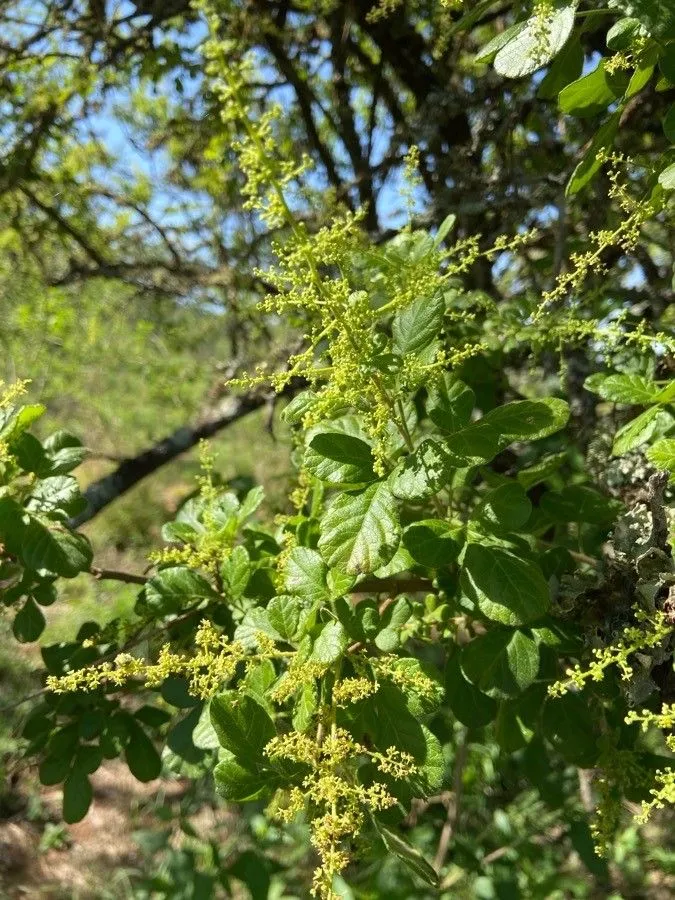
Author: (Burch.) Moffett
Bibliography: Bothalia 37: 171 (2007)
Year: 2007
Status: accepted
Rank: species
Genus: Searsia
Vegetable: False
Observations: Ethiopia to S. Africa
Common taaibos, scientifically known as Searsia pyroides, is a resilient plant that belongs to the Anacardiaceae family. This species exhibits considerable adaptability and a wide geographical distribution, spanning from Ethiopia in the northeast of Africa down to South Africa in the southernmost regions of the continent.
Found primarily in a variety of habitats, Searsia pyroides thrives in both dry and moist areas, showcasing its versatility and hardiness. It is well-regarded not only for its ecological importance but also for its role in traditional practices and as a component of the natural landscape.
The shrub or small tree is often recognized by its robust structure, typically growing to substantial sizes under favorable conditions. The leaves are trifoliate, which is characteristic of many plants in the Anacardiaceae family, and they present a lush, green appearance that can turn to striking shades during different seasons, adding aesthetic value to its environment.
Common taaibos produces small, inconspicuous flowers that are nonetheless crucial for the local ecosystem, attracting a variety of pollinators. Following the flowering period, it bears small drupe fruits that serve as a food source for birds and other wildlife, contributing to the biodiversity of their habitats.
Ecologically, Searsia pyroides plays a significant role in soil stabilization and restoration projects. Its extensive root system helps prevent soil erosion, making it an excellent choice for rehabilitating degraded lands and maintaining the integrity of the soil.
While Searsia pyroides has adapted to a wide range of environmental conditions, it faces challenges from habitat loss and changing climatic conditions, which underscores the importance of conservation efforts to ensure its continued presence in its native regions.
For further scientific details and academic studies about Searsia pyroides, reference can be made to the work documented in Bothalia 37: 171 (2007) by the author Moffett, which provides an in-depth examination of this versatile and ecologically significant species.
En: Common taaibos, Thorny karee
Af: Gewone taaibos
Nl: Gewone taaibos
Taken Jul 26, 2021 by Maarten Vanhove (cc-by-sa)
Taken Aug 9, 2022 by Douw (cc-by-sa)
Taken Jul 26, 2021 by Maarten Vanhove (cc-by-sa)
Taken Feb 28, 2021 by Leigh Winowiecki (cc-by-sa)
Taken Feb 28, 2021 by Leigh Winowiecki (cc-by-sa)
Taken Apr 14, 2022 by Vadim Panov (cc-by-sa)
Taken Jul 26, 2021 by Maarten Vanhove (cc-by-sa)
Taken Feb 28, 2021 by Leigh Winowiecki (cc-by-sa)
Taken Apr 14, 2022 by Vadim Panov (cc-by-sa)
Taken Jul 26, 2021 by Maarten Vanhove (cc-by-sa)
Taken Dec 4, 2021 by Elliot Kinsey (cc-by-sa)
Taken Feb 28, 2021 by Leigh Winowiecki (cc-by-sa)
© copyright of the Board of Trustees of the Royal Botanic Gardens, Kew.
Family: Myrtaceae Author: (F.Muell.) K.D.Hill & L.A.S.Johnson Bibliography: Telopea 6: 402 (1995) Year: 1995 Status:…
Family: Rubiaceae Author: Pierre ex A.Froehner Bibliography: Notizbl. Bot. Gart. Berlin-Dahlem 1: 237 (1897) Year:…
Family: Sapindaceae Author: Koidz. Bibliography: J. Coll. Sci. Imp. Univ. Tokyo 32(1): 38 (1911) Year:…
Family: Asteraceae Author: A.Gray Bibliography: Pacif. Railr. Rep.: 107 (1857) Year: 1857 Status: accepted Rank:…
Family: Fabaceae Author: Medik. Bibliography: Vorles. Churpfälz. Phys.-Ökon. Ges. 2: 398 (1787) Year: 1787 Status:…
Family: Aspleniaceae Author: (Cav.) Alston Bibliography: Bull. Misc. Inform. Kew 1932: 309 (1932) Year: 1932…